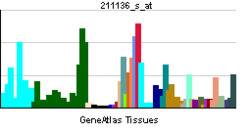- Cleft lip and palate transmembrane protein 1
-
Cleft lip and palate associated transmembrane protein 1 Identifiers Symbols CLPTM1; External IDs OMIM: 604783 MGI: 1927155 HomoloGene: 37464 GeneCards: CLPTM1 Gene Gene Ontology Cellular component • integral to plasma membrane
• external side of plasma membrane
• membraneBiological process • multicellular organismal development
• cell differentiation
• regulation of T cell differentiation in thymusSources: Amigo / QuickGO RNA expression pattern 

More reference expression data Orthologs Species Human Mouse Entrez 1209 56457 Ensembl ENSG00000104853 ENSMUSG00000002981 UniProt O96005 Q8VBZ3 RefSeq (mRNA) NM_001199468.1 NM_019649.2 RefSeq (protein) NP_001186397.1 NP_062623.2 Location (UCSC) Chr 19:
45.46 – 45.5 MbChr 7:
20.22 – 20.25 MbPubMed search [1] [2] Cleft lip and palate transmembrane 1 Identifiers Symbol CLPTM1 Pfam PF05602 InterPro IPR008429 Available protein structures: Pfam structures PDB RCSB PDB; PDBe PDBsum structure summary Cleft lip and palate transmembrane protein 1 is a protein that in humans is encoded by the CLPTM1 gene.[1][2] It belongs to a family of several eukaryotic cleft lip and palate transmembrane protein 1 sequences.
Cleft lip with or without cleft palate is a common birth defect that is genetically complex. The nonsyndromic forms have been studied genetically using linkage and candidate-gene association studies with only partial success in defining the loci responsible for orofacial clefting. CLPTM1 encodes a transmembrane protein and has strong homology to two Caenorhabditis elegans genes, suggesting that CLPTM1 may belong to a new gene family.[3] This family also contains the Homo sapiens cisplatin resistance related protein CRR9p which is associated with CDDP-induced apoptosis.[4]
References
- ^ Yoshiura K, Machida J, Daack-Hirsch S, Patil SR, Ashworth LK, Hecht JT, Murray JC (Jan 1999). "Characterization of a novel gene disrupted by a balanced chromosomal translocation t(2;19)(q11.2;q13.3) in a family with cleft lip and palate". Genomics 54 (2): 231–40. doi:10.1006/geno.1998.5577. PMID 9828125.
- ^ "Entrez Gene: CLPTM1 cleft lip and palate associated transmembrane protein 1". http://www.ncbi.nlm.nih.gov/sites/entrez?Db=gene&Cmd=ShowDetailView&TermToSearch=1209.
- ^ Murray JC, Yoshiura K, Machida J, Daack-hirsch S, Patil SR, Ashworth LK, Hecht JT (1998). "Characterization of a novel gene disrupted by a balanced chromosomal translocation t(2;19)(q11.2;q13.3) in a family with cleft lip and palate". Genomics 54 (2): 231–240. doi:10.1006/geno.1998.5577. PMID 9828125.
- ^ Yamamoto K, Okamoto A, Isonishi S, Ochiai K, Ohtake Y (2001). "A novel gene, CRR9, which was up-regulated in CDDP-resistant ovarian tumor cell line, was associated with apoptosis". Biochem. Biophys. Res. Commun. 280 (4): 1148–1154. doi:10.1006/bbrc.2001.4250. PMID 11162647.
Further reading
- Maruyama K, Sugano S (1994). "Oligo-capping: a simple method to replace the cap structure of eukaryotic mRNAs with oligoribonucleotides.". Gene 138 (1-2): 171–4. doi:10.1016/0378-1119(94)90802-8. PMID 8125298.
- Takeuchi T, Kuro-o M, Miyazawa H, et al. (1997). "Transgenic expression of a novel thymic epithelial cell antigen stimulates aberrant development of thymocytes.". J. Immunol. 159 (2): 726–33. PMID 9218588.
- Suzuki Y, Yoshitomo-Nakagawa K, Maruyama K, et al. (1997). "Construction and characterization of a full length-enriched and a 5'-end-enriched cDNA library.". Gene 200 (1-2): 149–56. doi:10.1016/S0378-1119(97)00411-3. PMID 9373149.
- Strausberg RL, Feingold EA, Grouse LH, et al. (2003). "Generation and initial analysis of more than 15,000 full-length human and mouse cDNA sequences.". Proc. Natl. Acad. Sci. U.S.A. 99 (26): 16899–903. doi:10.1073/pnas.242603899. PMC 139241. PMID 12477932. http://www.pubmedcentral.nih.gov/articlerender.fcgi?tool=pmcentrez&artid=139241.
- Gerhard DS, Wagner L, Feingold EA, et al. (2004). "The status, quality, and expansion of the NIH full-length cDNA project: the Mammalian Gene Collection (MGC).". Genome Res. 14 (10B): 2121–7. doi:10.1101/gr.2596504. PMC 528928. PMID 15489334. http://www.pubmedcentral.nih.gov/articlerender.fcgi?tool=pmcentrez&artid=528928.
- Rossi MR, Hawthorn L, Platt J, et al. (2005). "Identification of inactivating mutations in the JAK1, SYNJ2, and CLPTM1 genes in prostate cancer cells using inhibition of nonsense-mediated decay and microarray analysis.". Cancer Genet. Cytogenet. 161 (2): 97–103. doi:10.1016/j.cancergencyto.2005.02.006. PMID 16102578.
- Lewandrowski U, Moebius J, Walter U, Sickmann A (2006). "Elucidation of N-glycosylation sites on human platelet proteins: a glycoproteomic approach.". Mol. Cell Proteomics 5 (2): 226–33. doi:10.1074/mcp.M500324-MCP200. PMID 16263699.
- Otsuki T, Ota T, Nishikawa T, et al. (2007). "Signal sequence and keyword trap in silico for selection of full-length human cDNAs encoding secretion or membrane proteins from oligo-capped cDNA libraries.". DNA Res. 12 (2): 117–26. doi:10.1093/dnares/12.2.117. PMID 16303743.
Categories:- Human proteins
- Chromosome 19 gene stubs
Wikimedia Foundation. 2010.
